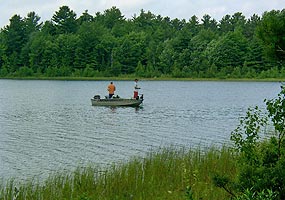|
You are viewing ARCHIVED content published online before January 20, 2025.
Please note that this content is NOT UPDATED, and links may not work. For current information,
visit https://www.nps.gov/aboutus/news/index.htm.

NPS photo Non-native Virus Poses Serious Threat to Native Fish and Ecosystems The four units of the National Park System on Lake Superior and the Grand Portage Band of the Lake Superior Chippewa are working to develop a plan to protect park and tribal fishery resources from the latest aquatic invasive that threatens native fish and ecosystems, viral hemorrhagic septicemia, or VHS. The four NPS units currently involved in the planning effort include Apostle Island National Lakeshore in Wisconsin, Grand Portage National Monument in Minnesota, and Isle Royale National Park and Pictured Rocks National Lakeshore in Michigan. The Grand Portage Band joined this effort to protect traditional access of Ojibwe people to the fish species they have harvested through time and because of their sharing management at the Grand Portage National Monument. VHS is a deadly fish virus that was first detected in the lower Great Lakes in 2003 and continues to spread to additional locations each year. To date, it has not been found in Lake Superior. While the virus does not affect humans, it is known to infect at least 28 species of freshwater fish, including many popular species for both commercial and recreational fishing and has been the cause of large fish kills in other parts of the Great Lakes. It spreads between fish through urine, feces and reproductive fluids released into the water and through the eating of other infected fish. Known or suspected human vectors for spread of the disease include ballast water exchange, spread of infected water and fish parts by commercial and recreational boaters and the movement of infected fish or the use of infected bait for fishing. The four parks contain some of the most productive fisheries in the Lake Superior basin, and at Isle Royale, three phenotypes and possible several morphological variants of lake trout. “These park resources and the visitor experience are at high risk of being significantly impacted by VHS,” said National Park Service Regional Fisheries Biologist Jay Glase. To develop an effective plan as quickly as possible, the NPS Midwest Regional Director, the superintendents of the four NPS areas, and the Grand Portage Band activated the National Park Service’s national incident management team, which specializes in planning for and responding to large scale emergencies and special events. During the week of January 14-18 the team assembled a panel of NPS and subject matter experts to draft an initial plan, which is currently under further review by the parks, the respective states and a broad range of organizations and subject matter experts. The plan is focused on preventing (to the largest degree possible), detecting and responding to VHS in the waters of these four parks. The plan will assist park managers and staff in assessing the risk of VHS introduction and subsequently planning and implementing the appropriate levels of prevention and monitoring actions in their respective areas of responsibility. The plan will also provide a framework for emergency response should an introduction be discovered within or near NPS areas. “We have a clear legal responsibility to do everything we can to protect the integrity of park resources,” said NPS Regional Director Ernie Quintana, “but it is also clear that we can not do it alone when it comes to VHS.” “This is a complex issue, over which we do not have full control or jurisdiction, with ramifications for important fishery resources in both the United States and Canada. To prevent this disease from impacting the fishery resources in the park units for which we are responsible will require sensitive and sophisticated collaboration between Canada and the U.S., a number of other agencies, the respective states, the commercial shipping and fishing industry, local citizens and the visitors to these parks,” Quintana added. “I know we have been moving quickly, but are truly grateful to everyone who has been and will be working with us on this important effort.” Agencies currently assisting the National Park Service in development and/or review of the plan include the U.S. Fish and Wildlife Service, the U.S. Forest Service, the U.S. Environmental Protection Agency, the U.S. Department of Agriculture’s Animal and Plant Health Inspection Service, the U.S. Coast Guard, the Great Lakes Indian Fish and Wildlife Commission, the Great Lakes Commission, the U.S. Geological Survey, the National Oceanic and Atmospheric Administration’s National Center for Aquatic Invasive Species, the Sea Grant Programs and Departments of Natural Resources from Wisconsin, Minnesota and Michigan. “We will be working very closely with the Michigan Department of Natural Resources, the Natural Resources Commission, Michigan Sea Grant, other federal, state and local agencies, and local fishing organizations to do everything we can to keep VHS out of not only Lake Superior, but the inland lakes and streams of Pictured Rocks as well,” emphasized Pictured Rocks National Lakeshore superintendent Jim Northup. -NPS- For more VHS information: |
Last updated: August 20, 2021
